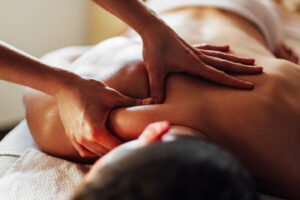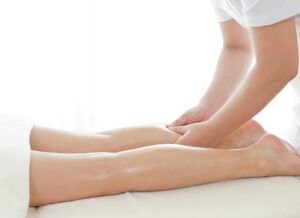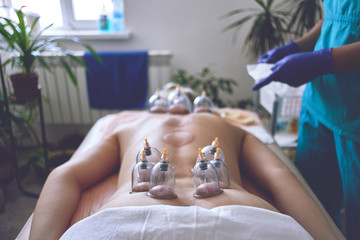Massage manipulates the soft tissues of the body (muscles, tendons, and ligaments) to reduce pain and improve flexibility. Massage stimulates the parasympathetic nervous system, which can decrease the stress hormone cortisol, increase serotonin and dopamine, and promote relaxation and good health.

Massage can also reduce lactic acid buildup in muscles, prevent adhesions, and enhance range of motion. Visit https://www.flowstate918.com/ for more information.
Studies show massage can improve various physical symptoms, including back pain and headaches. For example, a study of people with chronic neck pain found those receiving massage reported less discomfort and improved function than those who did not get a rubdown. Another study of patients with fibromyalgia, a condition that causes muscle and joint pain, found those receiving regular massage had less symptom severity than those who did not receive touch therapy.
Researchers have attributed these results to the calming effect of moderate pressure applied to the skin during massage, which can slow your nervous system down and reduce heart rate and blood pressure. This in turn can impact hormones that cause stress, leading to a natural relaxation and reduction in a variety of ailments.
Massage may help ease the symptoms of a number of diseases, including fibromyalgia, rheumatoid arthritis and low back pain. People undergoing cancer treatments, such as chemotherapy and radiation, also benefit from massage therapy, which can ease anxiety and fatigue and help manage side effects like nausea and vomiting. Massage can improve range of motion in joints by keeping the ligaments flexible and lubricated, helping with arthritic conditions.
It has also been shown to relieve a variety of other conditions, including anxiety, insomnia, migraines and depression. Practitioners claim that massage can also boost self-esteem, particularly in individuals with disabilities and terminal illnesses. This is likely due to the sense of caring and positive emotions that are often associated with massage, which can help people feel cared for and connected.
The immune system also benefits from massage. A study of HIV-positive children who received frequent massages found that they had higher levels of the body’s natural killer cells than those who did not get a regular rubdown. In addition, an abdominal massage can relieve chronic constipation by triggering the stretch receptors in the intestines and rectum to contract, which leads to more regular bowel movements.
Newborns also reap the health benefits of massage, which can enhance their motor skills and encourage an emotional bond with their mothers. Infants who are massaged tend to cry less and are more active, alert and sociable. Research has also indicated that babies who are massaged by their mothers have higher oxytocin levels, a hormone that promotes social bonding and generosity.
Techniques
Massage is often used to treat specific muscles and joints. It can also be applied to areas with stiffness or pain and can help increase blood flow. This makes it an important tool for many types of health care and is used in hospitals and hospices. It is said that it helps patients feel more comfortable, which can lead to better communication with their health care providers. Massage is also used in conjunction with mental health treatment, as it has been found to reduce anxiety and depression.
There are several different techniques that can be used in massage, such as effleurage, friction, tapotement, and vibration. Effleurage involves stroking movements of the hands sliding over a person’s skin, and it is usually the first and last technique used in a massage. It is a common massage technique that can be modified in intensity and speed according to the person’s needs.
Kneading, a more intense form of effleurage, is when the hand or fingers are pressed into muscle fibers to break up muscle knots. Friction is another more intense technique that consists of circular movement of the thumb and fingers against the skin. Tapotement, a fast rhythmic touch on the body, is a stimulating technique that can wake up a sleepy client.
Vibration is another method that can be used in massage, and it involves shaking the hands against the person’s skin. This is a soothing and relaxing technique that can be done on a large surface area such as the legs or arms.
Other forms of massage include sports massage, which is designed to assist athletic training and to aid recovery from injuries. There is some scientific evidence that this type of massage can reduce lactic acid buildup in muscles, and it can help improve range of motion.
Other methods of massage are used in health care settings, including some hospices and units for people with mental disabilities or addictions. It is said that patients are more willing to discuss psychological issues with their providers when they feel relaxed and cared for, which can lead to improved outcomes in treatment.
Preparation
Getting massaged can be quite a relaxing experience. The therapist needs to have a good understanding of the client’s body so that they can manipulate the muscles and tendons effectively. The client should also communicate clearly to the therapist what parts of their body they are comfortable having touched.
If the client is unsure of what type of massage they want, they should make the therapist aware of this before the session starts. The therapist would then be able to offer suggestions on what type of massage they might find most beneficial.
The client should dress comfortably before the session begins. A sheet or towel is provided for draping during the massage, and the therapist will only uncover the areas of the body that are being worked on, ensuring that modesty is respected at all times. It is a good idea for the client to take a shower before their massage so that they can feel clean and refreshed after the massage is over.
It is best to avoid eating a large meal immediately before a massage appointment. This is because it can be difficult to relax while you are trying to digest a heavy meal. A light snack is a better option.
After the massage is over, it is important to slowly get up off of the table and onto your feet. Getting up too quickly can cause dizziness and light headedness. It is also important to take the time to stretch your arms and legs, and to get dressed.
The therapist should provide a clean environment, including the massage table, pillows, blankets and face cradle covers. They should also ensure that they have all of the supplies they need for the massage, such as massage oil, lotion, and powders. The therapist should also be aware of any open wounds or cuts on the client’s body. In addition, the therapist should know if the client has any allergies to certain oils, lotions or powders that may be used during the massage. This will help the therapist to choose the right oil or lotion for the individual’s needs.
Post-massage care
Depending on the intensity of your massage, it is normal to feel some soreness after the session. This is especially true with therapeutic or deep tissue massage. Tissue soreness can be uncomfortable, but it is also a natural part of the healing process. The good news is that it should subside within 24-48 hours. Taking a few steps to care for yourself after your massage can help reduce the discomfort and speed up the healing process.
It is recommended to drink plenty of water after a massage, as it will help flush the toxins out of your body. This will also increase circulation which helps to decrease the soreness. Try to hydrate for at least a few hours after your massage, but make sure not to eat a large meal right after. Having too much food in the digestive system can cause it to work overtime, and may interfere with the beneficial effects of your massage.
Stretching gently after a massage is a great way to ease soreness and improve flexibility and range of motion. Many massage therapists will provide stretching guidelines for you to follow at home.
Another great way to reduce soreness after a massage is by applying ice to your muscles. This will relieve inflammation and decrease soreness and swelling. You can buy ice packs at most pharmacies or grocery stores, or you can make your own by filling a plastic bag with ice and putting it in the freezer.
If you have trouble sleeping after a massage, it can be helpful to take a warm bath or shower with Epsom salts to help soothe your muscles. You can also take a nap or go to sleep earlier than usual. Getting lots of rest is a key element in the healing process.
Massage is an effective treatment for muscle soreness, and it can also improve mood and increase energy levels. It is also an excellent form of preventative healthcare. Schedule a massage today to begin reaping the benefits of this relaxing and healing therapy!



